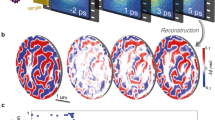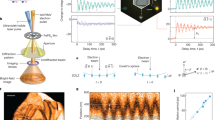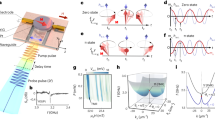Abstract
Understanding and control of the dynamic response of magnetic materials with a three-dimensional magnetization distribution is important both fundamentally and for technological applications. From a fundamental point of view, the internal magnetic structure and dynamics in bulk materials still need to be mapped1, including the dynamic properties of topological structures such as vortices2, magnetic singularities3 or skyrmion lattices4. From a technological point of view, the response of inductive materials to magnetic fields and spin-polarized currents is essential for magnetic sensors and data storage devices5. Here, we demonstrate time-resolved magnetic laminography, a pump–probe technique, which offers access to the temporal evolution of a three-dimensional magnetic microdisc with nanoscale resolution, and with a synchrotron-limited temporal resolution of 70 ps. We image the dynamic response to a 500 MHz magnetic field of the complex three-dimensional magnetization in a two-phase bulk magnet with a lateral spatial resolution of 50 nm. This is achieved with a stroboscopic measurement consisting of eight time steps evenly spaced over 2 ns. These measurements map the spatial transition between domain wall motion and the dynamics of a uniform magnetic domain that is attributed to variations in the magnetization state across the phase boundary. Our technique, which probes three-dimensional magnetic structures with temporal resolution, enables the experimental investigation of functionalities arising from dynamic phenomena in bulk and three-dimensional patterned nanomagnets6.
This is a preview of subscription content, access via your institution
Access options
Access Nature and 54 other Nature Portfolio journals
Get Nature+, our best-value online-access subscription
$29.99 / 30 days
cancel any time
Subscribe to this journal
Receive 12 print issues and online access
$259.00 per year
only $21.58 per issue
Buy this article
- Purchase on Springer Link
- Instant access to full article PDF
Prices may be subject to local taxes which are calculated during checkout




Similar content being viewed by others
Data availability
All data associated with this manuscript are available at https://doi.org/10.5281/zenodo.3660827.
Code availability
All analysis code and reconstruction algorithms associated with the work of this manuscript are available at https://doi.org/10.5281/zenodo.3660827.
References
Templeton, T. L., Hanham, S. D. & Arrott, A. S. Helical patterns of magnetization and magnetic charge density in iron whiskers. AIP Adv. 8, 056022 (2018).
Yan, M., Hertel, R. & Schneider, C. M. Calculations of three-dimensional magnetic normal modes in mesoscopic permalloy prisms with vortex structure. Phys. Rev. B. 76, 094407 (2007).
Im, M.-Y. et al. Dynamics of the Bloch point in an asymmetric permalloy disk. Nat. Commun. 10, 593 (2019).
Milde, P. et al. Unwinding of a Skyrmion lattice by magnetic monopoles. Science 340, 1076 (2013).
Hubert, A. & Schäfer, R. Magnetic Domains: The Analysis of Magnetic Microstructures (Springer, 1998).
Fernández-Pacheco, A. et al. Three-dimensional nanomagnetism. Nat. Commun. 8, 15756 (2017).
Raabe, J. et al. Quantitative analysis of magnetic excitations in landau flux-closure structures using synchrotron-radiation microscopy. Phys. Rev. Lett. 94, 217204 (2005).
Wintz, S. et al. Magnetic vortex cores as tunable spin-wave emitters. Nat. Nanotechnol. 11, 948 (2016).
Choe, S. B. et al. Vortex core-driven magnetization dynamics. Science 304, 420 (2004).
Van Waeyenberge, B. et al. Magnetic vortex core reversal by excitation with short bursts of an alternating field. Nature 444, 461–464 (2006).
Baumgartner, M. et al. Spatially and time-resolved magnetization dynamics driven by spin–orbit torques. Nat. Nanotechnol. 12, 980 (2017).
Finizio, S. et al. Dynamic imaging of the delay- and tilt-free motion of Néel domain walls in perpendicularly magnetized superlattices. Nano Lett. 19, 375–380 (2019).
Stein, F.-U. et al. Time-resolved imaging of nonlinear magnetic domain-wall dynamics in ferromagnetic nanowires. Sci. Rep. 3, 1737 (2013).
Vogel, J. et al. Direct observation of massless domain wall dynamics in nanostripes with perpendicular magnetic anisotropy. Phys. Rev. Lett. 108, 247202 (2012).
Woo, S. et al. Deterministic creation and deletion of a single magnetic skyrmion observed by direct time-resolved X-ray microscopy. Nat. Electron. 1, 288–296 (2018).
Büttner, F. et al. Dynamics and inertia of skyrmionic spin structures. Nat. Phys. 11, 225 (2015).
Wartelle, A. et al. Bloch-point-mediated topological transformations of magnetic domain walls in cylindrical nanowires. Phys. Rev. B. 99, 024433 (2019).
Donnelly, C. et al. Three-dimensional magnetization structures revealed with X-ray vector nanotomography. Nature 547, 328 (2017).
Suzuki, M. et al. Three-dimensional visualization of magnetic domain structure with strong uniaxial anisotropy via scanning hard X-ray microtomography. Appl. Phys. Express 11, 036601 (2018).
Hilger, A. et al. Tensorial neutron tomography of three-dimensional magnetic vector fields in bulk materials. Nat. Commun. 9, 4023 (2018).
Kardjilov, N. et al. Three-dimensional imaging of magnetic fields with polarized neutrons. Nat. Phys. 4, 399–403 (2008).
Manke, I. et al. Three-dimensional imaging of magnetic domains. Nat. Commun. 1, 125 (2010).
Tanigaki, T. et al. Three-dimensional observation of magnetic vortex cores in stacked ferromagnetic discs. Nano Lett. 15, 1309–1314 (2015).
Streubel, R. et al. Retrieving spin textures on curved magnetic thin films with full-field soft X-ray microscopies. Nat. Commun. 6, 7612 (2015).
Blanco-Roldan, C. et al. Nanoscale imaging of buried topological defects with quantitative X-ray magnetic microscopy. Nat. Commun. 6, 8196 (2015).
Donnelly, C. et al. High-resolution hard X-ray magnetic imaging with dichroic ptychography. Phys. Rev. B. 94, 064421 (2016).
Beaurepaire, E., Bulou, H., Scheurer, F. & Jean-Paul, K. (eds) Magnetism and Synchrotron Radiation (Springer, 2010).
Holler, M. et al. Three-dimensional imaging of integrated circuits with macro- to nanoscale zoom. Nat. Electron. 2, 464–470 (2019).
Donnelly, C. et al. Tomographic reconstruction of a three-dimensional magnetization vector field. New J. Phys. 20, 083009 (2018).
Kneller, E. F. & Hawig, R. The exchange-spring magnet: a new material principle for permanent magnets. IEEE Trans. Magn. 27, 3588–3560 (1991).
Ha, J. K., Hertel, R. & Kirschner, J. Micromagnetic study of magnetic configurations in submicron permalloy disks. Phys. Rev. B. 67, 224432 (2003).
Gatel, C. et al. Size-specific spin configurations in single iron nanomagnet: from flower to exotic vortices. Nano Lett. 15, 6952–6957 (2015).
Parkin, S. S. P., Hayashi, M. & Thomas, L. Magnetic domain-wall racetrack memory. Science 320, 190–194 (2008).
Allwood, D. A. et al. Magnetic domain-wall logic. Science 309, 1688–1692 (2005).
Kaka, S. et al. Mutual phase-locking of microwave spin torque nano-oscillators. Nature 437, 389–392 (2005).
Mancoff, F. B. et al. Phase-locking in double-point-contact spin-transfer devices. Nature 437, 393–395 (2005).
Odstrčil, M. et al. Towards optimized illumination for high-resolution ptychography. Opt. Express 27, 14981–14997 (2019).
Holler, M. & Raabe, J. Error motion compensating tracking interferometer for the position measurement of objects with rotational degree of freedom. Opt. Eng. 54, 054101 (2015).
Holler, M. et al. OMNY—a tomography nano cryo stage. Rev. Sci. Instrum. 89, 043706 (2018).
Guizar-Sicairos, M. et al. High-throughput ptychography using Eiger: scanning X-ray nano-imaging of extended regions. Opt. Express 22, 14859–14870 (2014).
Thibault, P. et al. High-resolution scanning x-ray diffraction microscopy. Science 321, 379–382 (2008).
Thibault, P. & Guizar-Sicairos, M. Maximum-likelihood refinement for coherent diffractive imaging. New J. Phys. 14, 063004 (2012).
Odstrčil, M. et al. Alignment methods for nanotomography with deep subpixel accuracy. Opt. Express 27, 36637–36652 (2019).
Donnelly, C. & Guizar-Sicairos, M. Magnetic tomography reconstruction algorithm v.1.0.1. (Zenodo, 2018); https://doi.org/10.5281/zenodo.1324335
Attwood, D. Soft X-Rays and Extreme Ultraviolet Radiation Ch. 9 (Cambridge Univ. Press, 1999).
van Heel, M. & Schatz, M. Fourier shell correlation threshold criteria. J. Struct. Biol. 151, 250–262 (2005).
Guizar-Sicairos, M., Thurman, S. T. & Fienup, J. R. Efficient subpixel image registration algorithms. Opt. Lett. 33, 156–158 (2008).
Acknowledgements
We thank D. Marty for initial discussions about the sample fabrication and design, E. Müller for focused ion beam patterning of the sample. All data was measured at the cSAXS beamline, Swiss Light Source, Paul Scherrer Institute, Switzerland. C.D. acknowledges funding from the Leverhulme Trust (grant no. ECF-2018-016), the Isaac Newton Trust (grant no. 18-08) and the L’Oréal-UNESCO UK and Ireland Fellowship for Women In Science 2019. A.H. was funded by the European Union's Horizon 2020 research and innovation programme under Marie Sklodowska-Curie grant agreement no. 794207 (ASIQS). S.M. acknowledges funding from the Swiss National Science Foundation under grant agreement no. 172517.
Author information
Authors and Affiliations
Contributions
C.D. and S.F. conceived the study of three-dimensional magnetic dynamics with input from J.R. Project discussions involved C.D., S.F., S.G., V.S, M.H., A.H., L.J.H., M.G.-S. and J.R. The sample fabrication was planned by C.D. and S.F. and performed by C.D., A.H. and S.M. The time-resolved electronics setup was designed and implemented by S.F. and J.R. The laminography endstation was designed and built by M.H. The diamond phase plate for the production of circular polarization was implemented by V.S. The synchrotron measurements were performed by C.D., S.F., M.G.-S., M.H., V.S. and J.R. The non-magnetic laminography reconstruction code was developed by M.O., and used by C.D. with the support of M.O. The magnetic laminography reconstruction was developed and used by C.D., with the support of M.G.-S. Data analysis was conducted by C.D. with the support of M.G.-S. The time-resolved three-dimensional magnetic data was interpreted by C.D., S.F., S.G. and M.G.-S. C.D. wrote the manuscript with contributions from all authors. The clarity of the final manuscript was ensured by C.D., S.G., L.J.H. and M.G.-S.
Corresponding authors
Ethics declarations
Competing interests
The authors declare no competing interests.
Additional information
Peer review information Nature Nanotechnology thanks Salvador Ferrer and the other, anonymous, reviewer(s) for their contribution to the peer review of this work.
Publisher’s note Springer Nature remains neutral with regard to jurisdictional claims in published maps and institutional affiliations.
Extended data
Extended Data Fig. 1 The error in the direction of the reconstructed magnetization vector field(Δθm) for different laminography tilt angles is determined by numerical simulations of magnetic laminography.
The simulations show that there exists a range of angles (40°–80°) for which the 3D structure can be reconstructed with a high degree of accuracy. The accuracy of the reconstruction is determined by calculating the RMS error of the direction of the reconstructed magnetization with respect to the original structure (Δθm). The tilt angle used in the experiment presented in this manuscript is 61°, which lies comfortably within this range and is indicated with an arrow.
Extended Data Fig. 2 Determination of the spatial resolution of the reconstructed magnetization by calculating the edge sharpness across the core of a vortex domain wall.
Line profiles of (a) the mx and (b) the mz components of the magnetization across the vortex domain wall. The 25%-75% edge sharpness is found to be on average 50 nm, indicating a half-period spatial resolution of 50 nm. c, The line along which the profile is measured is drawn in blue.
Extended Data Fig. 3 Determination of the spatial resolution of the reconstructed magnetization by calculating the Fourier Shell Correlation.
Fourier Shell Correlation of (a) the mx, (b) the my and (c) the mz components of the magnetization. An estimate of the spatial resolution is obtained using the 1/2 bit threshold36 (red dashed line) and is found to be 184 nm, 360 nm and 180 nm for the mx, my and mz components of the magnetization, respectively.
Extended Data Fig. 5 Comparison of the divergence and angular direction of the magnetization within a single slice, that are used for alignment purposes.
Images of a, ∇sin(θm) and b, sin(θm) of the lowest slice of the magnetization. One can see that for ∇sin(θm) in a, the signal is limited to the domain walls, whereas for sin(θm) the signal is non-zero in the majority of the structure.
Extended Data Fig. 6 Vortex domain wall displacement within the bulk of the microdisc.
Displacement of the vortex domain walls with negative vorticity (a, blue in left-hand panel and Fig. 4) and positive vorticity (b, red in left-hand panel and Fig. 4) in the direction perpendicular to the long axis of the domain wall (indicated by grey arrows in the left-hand panel) as a function of time for different heights within the structure. The oscillatory behaviour is clearest for both vortices at a height of 46 nm and is less clear at the top. When comparing the motion of the two vortex domain walls, the oscillations appear to be consistently out of phase through the height of the sample. Scale bar is 1 μm.
Supplementary information
Supplementary Video 1
Three-dimensional static magnetic configuration shown through the bulk of the microdisc.
Supplementary Video 2
Dynamic response of the three-dimensional magnetization at 500 MHz.
Supplementary Video 3
Domain wall dynamics in the lower region of the disc containing two vortex walls.
Rights and permissions
About this article
Cite this article
Donnelly, C., Finizio, S., Gliga, S. et al. Time-resolved imaging of three-dimensional nanoscale magnetization dynamics. Nat. Nanotechnol. 15, 356–360 (2020). https://doi.org/10.1038/s41565-020-0649-x
Received:
Accepted:
Published:
Issue Date:
DOI: https://doi.org/10.1038/s41565-020-0649-x
This article is cited by
-
Spatially reconfigurable antiferromagnetic states in topologically rich free-standing nanomembranes
Nature Materials (2024)
-
Three-dimensional spin-wave dynamics, localization and interference in a synthetic antiferromagnet
Nature Communications (2024)
-
Spin-wave-driven tornado-like dynamics of three-dimensional topological magnetic textures
Communications Physics (2024)
-
Bloch points and topological dipoles observed by X-ray vector magnetic tomography in a ferromagnetic microstructure
Communications Physics (2023)
-
A fast magnetic vector characterization method for quasi two-dimensional systems and heterostructures
Scientific Reports (2023)



